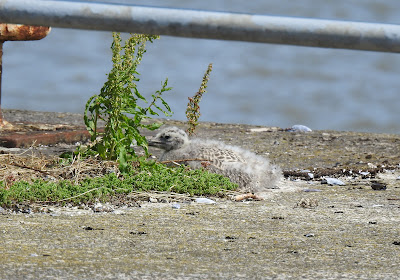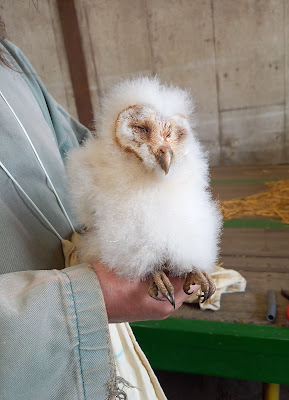I apologise for the Blog title as it's a bit of a mouthful, but it sums up what Gail and I have been up to in the great outdoors over the past few days.
The forecast for Wednesday morning looked good to get out, but there was a niggling strength to the north-westerly wind that meant it would be too breezy for ringing, so we headed to Foulshaw Moss instead, Foulshaw Moss being one of our favourite reserves. The plan was to head to the National Trust property of Sizergh Castle afterwards, so Gail could indulge her passion for history.
As soon as you get out of the car at Foulshaw Moss, Lesser Redpolls seem to be constantly 'buzzing' overhead, and this morning was no exception, as we had a conservative seven as we walked towards the second feeding station. This feeding station is viewed from the comfort of an open hide, and the feeders were busy with mainly Chaffinches, Greenfinches and Great Tits, as well as eight Goldfinches.
A couple of Swifts screamed overhead, and a Jay called from some Birch scrub. Two other 'callers' that remained heard and not seen, were two singing Reed Buntings.
Of course, one of the reasons that we love Foulshaw Moss so much is for the insects, but under the relatively cool and cloudy conditions they were fairly thin on the ground, but we did have a Common Hawker, a Black Darter, an Emperor Dragonfly, a Speckled Wood, eleven Small Whites, seven Common Darters and a Green-veined White.
One of the attractions of Foulshaw Moss for a lot of visitors is its pair of breeding Ospreys, and the reserve acts as a 'local honey pot' for people to see the species. The young Ospreys have now fledged, and we had views of three birds, but all were distant.
A run of birds all numbering two individuals included Raven, Great Spotted Woodpecker, Willow Warbler, Siskin and Long-tailed Tit.
I photographed some Wild Angelica on the peat bog towards the edge of some woodland, and when I was looking at the photographs, I noticed that there were six quite striking looking hoverflies on it. At the time I noticed that the Wild Angelica had lots of hoverflies coming and going, but I hadn't looked at them in any great detail. Anyway, I have identified them as Leucozona laternaria, unless anybody knows any different. The literature that I consulted tells me that they are common, but what striking beasties they are. You will need to click on the picture below, and then zoom in to see them.
zoom in)
A single Common Lizard and Roe Deer completed a couple of very pleasant hours.
I didn't think I would be mentioning our visit to Sizergh Castle on these pages, but as we were walking from the visitor reception to the house a 'flycatching' Spotted Flycatcher entertained us for a few minutes as it sallied forth for insects, unseen to us, from the branches of a tree and a stone wall. At times it was flying across a grassed area, stooping and diving, almost stopping in mid-air, changing direction, flicking left, flicking right, stalling, almost looping, all in the pursuit of flying insects. What a great bird! Later in the afternoon walking from the house to the gardens we had it, or another, doing more of the same.
We ran our moth trap over the night of Wednesday/Thursday for the first time in a while, and it was a fairly light catch of just seventeen moths of eight species. These were a Poplar Grey, five Dark Arches, two Large Yellow Underwings, five Common Rustics, a Cabbage Moth, a Turnip Moth, a Yellow Shell and a Codling Moth. Also in the light trap was a species of Common Green Lacewing.
Late Thursday morning, we took a walk along the quay overlooking some of the marshes on the Wyre estuary. We noticed a couple of virtually full-grown Herring Gull chicks on top of a modern building, and we checked on 'our' chick on the old ferry terminal, and it is looking a lot less fluffy now, and more like a young Herring Gull.
Swallow numbers were easily in double figures, and we were chatting to one of the fishermen about the Swallows that nest in the wrecks. I was commenting on what a safe place they were to nest, and he agreed, saying that the only predators that they were vulnerable to were rats. We did see a rat disappear into some stonework on the quay as we were admiring some Sea Lavender.
Swallow
A few, and I mean a few, waders are starting to appear on the mud in the quay, and we had a couple of Curlews and Oystercatchers, as well as nine Redshanks.
We didn't expect many butterflies or day-flying moths to be on the wing as it was quite windy during our walk, but we did have eleven Small Whites, a Silver Y, three Common Blues, five Gatekeepers, four Meadow Browns, two Red Admirals and two Commas.
Yesterday saw us ringing some Barn Owl chicks with or good friend Robert, on a farm near Garstang. The Barn Owls were in a box that Robert had built and supplied to one of his farming neighbours, and it was very high in the apex of a modern barn. The box was accessible from the top of some straw bales, but getting on top of the bales would have been a bit of a challenge if it wasn't for the farm's Manitou telehandler. Safely stood in the man basket, Robert and I were lifted to the full extent of the Manitou's 10 metre reach, and it was just a case of stepping out of the man basket and strolling along on top of the straw bales, some 30 plus feet above the ground, surreal really, but completely safe!
Two chicks, about three weeks old, were in the box, and were duly ringed. It will be about another 4 - 5 weeks before they fledge. Barn Owls seem to be having mixed fortunes in the UK this year, with birds in England seemingly nesting late, or struggling with small broods, while in Scotland they have had a bumper year with large broods, and early fledging. It will all be linked to prey availability, which tends to be cyclical, and weather. Fingers crossed for a better year next year.
That was the end of a few very enjoyable days out in the field this week, and looking at the forecast for the week ahead, it might be a few days yet before it is fit to get out again.











No comments:
Post a Comment